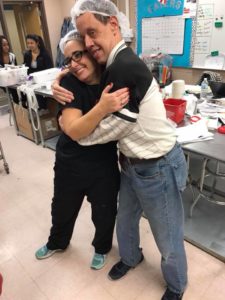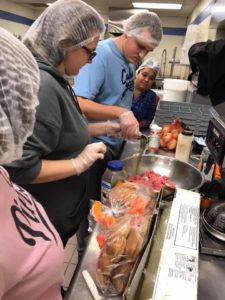Imagine you are a high school junior the morning of your first day at your new career tech center. Maybe you’ve enrolled in a half-day automotive, culinary, computer programming or health careers program. What do you envision? How do you hope the day will go? Do you hope to learn differently than you did in your traditional high school?
If you’re like many students, the answer is a resounding “YES!” You anticipate getting your hands on tools, moving among peers in a lab, and listening to an instructor’s experiences from the field. You are ready to have a new instructor who will fuel your excitement to begin a career and technical education (CTE) experience.
However, a basic principle of psychology could disrupt your plans. All human beings assess and understand new people and new situations by fitting them into mental schemas — existing frameworks created by past experiences with similar people and situations. And the schemas in our brains play a role in releasing dopamine. Novelty brings a dopamine reward to the brain.
Imagine you’re that student, walking into your new classroom, excited for a change, only to discover it fits your existing schema for traditional classroom learning. Your brain misses out on dopamine, and your anticipation quickly dissipates. It’s your first day in what you expected to be a brand new kind of school, yet already there is more of the same.
A First Day Re-imagined
Our staff decided last year that we would all design a day one that would not disappoint these energized students.
No classroom had columns and rows. No students were immediately given rules and procedures. What they were given was a challenge! Not all teachers gave the same challenge — but they all led some cooperative and competitive challenge that demonstrated a new type of expectations. The intended message to students was, they would be asked to process together, to make decisions, practice leadership, and frequently provide feedback to one another.
A student walked into a computer repair classroom to begin her IT pathway. The classroom featured tables in a U shape in the center of the room. Across each of the tables was an organized computer repair station with broken computers and numerous parts spread about. The student and her classmates were greeted by the teacher and were told to have a seat at any station with a partner. They were presented with a simple assignment: “Using any resources at your disposal and one student partner, reassemble the computer in under 40 minutes. Go!”
On the other side of campus, construction students walked in to find piles of newspapers and duct tape. Their task was to build the tallest freestanding tower in 30 minutes, using nothing but those two supplies.
In the cosmetology and culinary classes, however, the excitement rose to a whole new level. Students in these classrooms found stations of stacked solo cups with a strange looking tool attached. The tool was made of a standard rubber band with four, two-feet long pieces of yarn attached. The challenge here was to build a tower where six cups made the base, followed by a row of five, four, three, two and one on top. The catch was that they could ONLY touch the yarn.
The Strategy in Action: Build a cup tower!
How it Works
- Set out a stack of 21 plastic cups on each table designed to fit four students. A rubber band should be secured to the bottom of the top cup. Attach four, two-feet lengths of yarn to the rubber band spaced equally apart.
- Clear the table of anything except the cups.
- Explain to the teams that the objective is to build a tower where the base is six cups long, and continue to build until they place one cup at the top of the tower. Students are not to touch anything but the yarn. Even if the cups fall to the floor — which can easily happen! The objective is of course to be the first team to complete their tower successfully.
- Let the games begin! Facilitate the room, making your observations and enjoy learning about your new students and how they interact with one another.
Final Thoughts
This “start strong” approach stretches students’ imaginations and expectations. It brings the lab’s free movement, shared processing, student agency and relevance right into the classroom and helps students practice the kinds of collaborative skills they’ll be honing all year. The challenge involves critical thinking, adaptability, innovation, even literacy, all without seeming like “school work.”
The real beauty to this is also what it affords teachers. Within the very first hour of the new school year, teachers can observe students in a charged environment. They can quickly assess who are the natural leaders, who are the loquacious kids, who are quiet, who frustrates easily, and who loves a good challenge. Teachers can move right into conversations about learning in a CTE environment versus traditional schools. Teachers can also segue right into their expectations for collaborating, critical thinking, oral communication, and learning to adapt to new situations.
Sandra Adams is a teacher and instructional coach with the Career Academy, Fort Wayne Community Schools. She co-wrote the ACTE-supported book But I’m NOT a Reading Teacher!: Literacy Strategies for Career and Technical Educators with Gwendolyn Leininger. Contact her to learn how you can implement theses certification test prep and other innovative teaching strategies in your CTE classroom.

 On Dec. 14, 2018, Bona Vista and Kokomo Area Career Center, in Kokomo, Indiana, hosted the Sock Hop >amp; Roll. The event was designed by Keegan Paul, a career center student and Bona Vista intern, to offer “adults with disabilities a fun night of dancing, snacking and socializing.” The event was a success! Success that is due, at least in part, to collaboration among career and technical educators — and with business and community partners.
On Dec. 14, 2018, Bona Vista and Kokomo Area Career Center, in Kokomo, Indiana, hosted the Sock Hop >amp; Roll. The event was designed by Keegan Paul, a career center student and Bona Vista intern, to offer “adults with disabilities a fun night of dancing, snacking and socializing.” The event was a success! Success that is due, at least in part, to collaboration among career and technical educators — and with business and community partners. “My Kokomo Area Career Center students learn to work together with people from all walks of life. These experiences will serve our culinary arts students well in any situation,” said Shelley Rust, culinary arts instructor and past president of
“My Kokomo Area Career Center students learn to work together with people from all walks of life. These experiences will serve our culinary arts students well in any situation,” said Shelley Rust, culinary arts instructor and past president of  The event offered a unique opportunity for career and technical education students to gain real-world experience and have some fun, too. Culinary arts students developed recipes and conducted tastings with Bona Vista Bistro clients to create the menu. Students in the Kokomo Area Career Center’s cosmetology program styled hair and makeup for the guests, while media marketing students played paparazzi. Those enrolled in the certified nursing assistant program volunteered to provide aid to attendees as needed.
The event offered a unique opportunity for career and technical education students to gain real-world experience and have some fun, too. Culinary arts students developed recipes and conducted tastings with Bona Vista Bistro clients to create the menu. Students in the Kokomo Area Career Center’s cosmetology program styled hair and makeup for the guests, while media marketing students played paparazzi. Those enrolled in the certified nursing assistant program volunteered to provide aid to attendees as needed.




